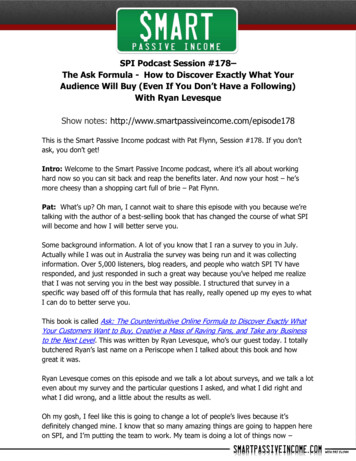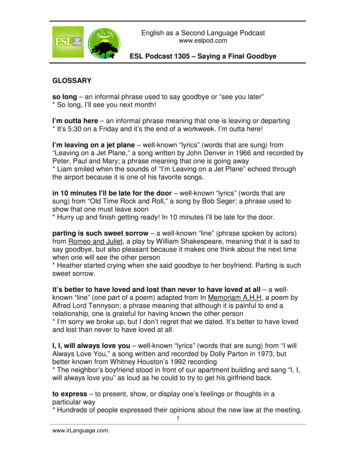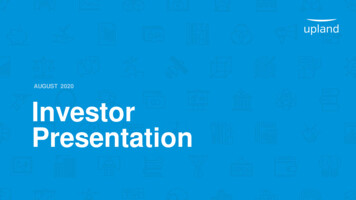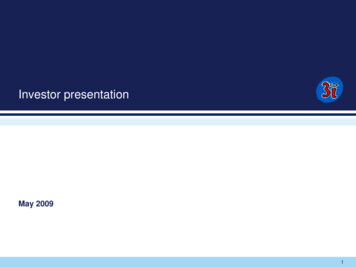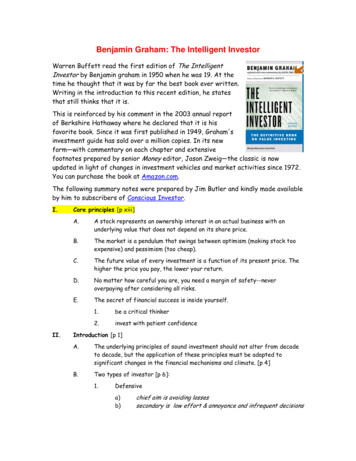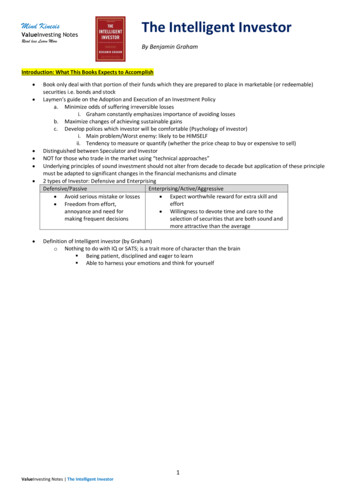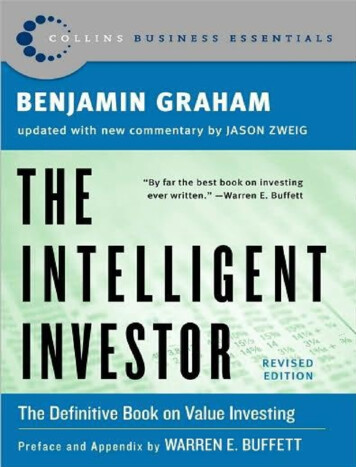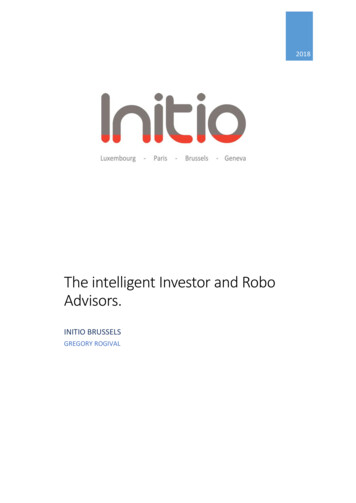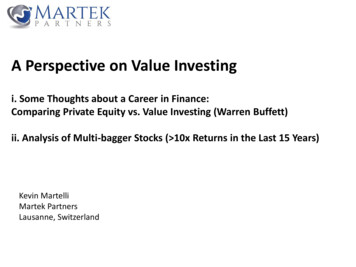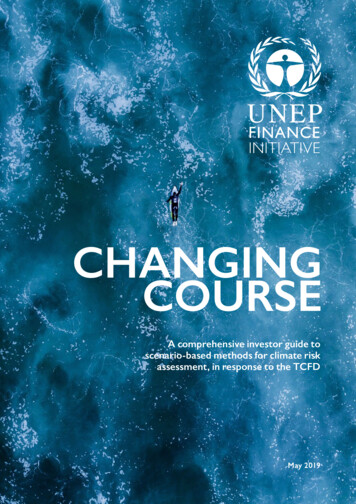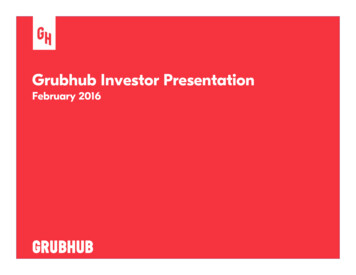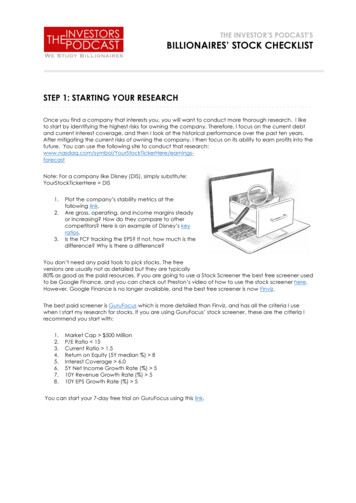
Transcription
THE INVESTOR’S PODCAST’SBILLIONAIRES’ STOCK CHECKLISTSTEP 1: STARTING YOUR -------------------------------Once you find a company that interests you, you will want to conduct more thorough research. I liketo start by identifying the highest risks for owning the company. Therefore, I focus on the current debtand current interest coverage, and then I look at the historical performance over the past ten years.After mitigating the current risks of owning the company, I then focus on its ability to earn profits into thefuture. You can use the following site to conduct that /earningsforecastNote: For a company like Disney (DIS), simply substitute:YourStockTickerHere DIS1.2.3.Plot the company’s stability metrics at thefollowing link.Are gross, operating, and income margins steadyor increasing? How do they compare to othercompetitors? Here is an example of Disney’s keyratios.Is the FCF tracking the EPS? If not, how much is thedifference? Why is there a difference?You don’t need any paid tools to pick stocks. The freeversions are usually not as detailed but they are typically80% as good as the paid resources. If you are going to use a Stock Screener the best free screener usedto be Google Finance, and you can check out Preston’s video of how to use the stock screener here.However, Google Finance is no longer available, and the best free screener is now Finviz.The best paid screener is GuruFocus which is more detailed than Finviz, and has all the criteria I usewhen I start my research for stocks. If you are using GuruFocus’ stock screener, these are the criteria Irecommend you start with:1.2.3.4.5.6.7.8.Market Cap 500 MillionP/E Ratio 15Current Ratio 1.5Return on Equity (5Y median %) 8Interest Coverage 6.05Y Net Income Growth Rate (%) 510Y Revenue Growth Rate (%) 510Y EPS Growth Rate (%) 5You can start your 7-day free trial on GuruFocus using this link.
THE INVESTOR’S PODCAST’SBILLIONAIRES’ STOCK CHECKLISTSTEP 2: LOCATE THE ---------------------------Buffett describes a “moat” as an item that protects thecompany from competitors. Think of Castles in medievaltimes. The moat is what protected the citizens frominvaders. The list is truly what keeps your companycompetitive. If you’re investing in a company with very highmargins (typically classified as a “growth pick”), you’lldefinitely want to ensure you’ve got a very wide moat.High margins attract competitors like meat wagons attractdogs. Here’s a great article about this idea.Here are examples of the moats I like to see for my stockpicks:1.2.3.4.5.Brand / Trade MarksProprietary TechnologyPatents / CopyrightsTrade SecretsThe stickiness of Product (Think Microsoft Office)STEP 3: INVEST LIKE THE BESTWITH THE INVESTOR’S ------------------------------You’re probably asking yourself how and where you should continue your journey and learn moreabout Warren Buffett and stocks investing.If you would like to learn more about how Warren Buffett and other billionaires invest, I stronglyrecommend that you check out our free podcast: “The Investor’s Podcast.”We interview famous value investors including billionaire Howard Marks, Bill Miller, Mohnish Pabrai, andGuy Spier, and talk about how you can apply their teachings in your portfolio. Make sure to subscribeto our weekly podcast by clicking on one of the icons where you listen to podcasts.
THE INVESTOR’S PODCAST’SBILLIONAIRES’ STOCK CHECKLISTADDITIONAL NOTES FOR USING THE --------------------------------When opening MorningStar.com, I typically use the “Key Ratios”, “Financials”, and “Valuation” tabs themost. I typically start at the top of each page and read down. Typically, a company that has greatleadership also has great financials. This is where I spend most of my time trying to understand thedecision making of the company leadership. By looking at the numbers, you can see how thecompany manages debt, how they employ retained earnings, and many other things. This is where youreally need to operate and understand things.1.2.3.4.If you’re using our stability-graph, you’ll find the important information on the “Key Ratios” tab.If you see unwanted things in the stability of the company, understand why they exist.For industry research, you’ll find the “Valuation” tab helpful for a cursory look. You’ll want tofind the #1 competitor for your company of interest and analyze their entire financialstatements if you want to conduct thorough research on industry peers.The margins of the company are important because they demonstrate the company’scurrent competitive environment. It also demonstrates how quickly they will be able to growin the future. If margins are high, the company will likely face fierce competition in the future.This is where you’ll want to look at Step 3 to help identify how you can mitigate/protect thosemargins.The FCF is the magic number. If you see fluctuation here, it might not necessarily be a badthing; it might just mean that the company had a substantial capital expenditure. These maycome every 3-5 years. If this is the case, make sure you understand why and how it mightimpact things in the future. The FCF is the money that the company actually has to invest andgrow the business. Think of it like this; when you get your paycheck every month, how much doyou have left after all your normal monthly expenses are paid? – That’s your FCF. This is themoney you use to invest and grow your equity. It’s the same thing for a business. If you’re usingMorningStar for research, you’ll find some valuable information at the bottom of the “KeyRatios” tab. The subordinate tab is called “Cash Flow.”WHICH BROKER I RECOMMEND AND --------------------------So, I actually use two different brokers because there areadvantages and disadvantages for the way I have thingsset-up. To start, a broker is nothing more than a companythat conducts trades on your behalf.I encourage people to separate their research tools fromtheir broker(s). I personally find the recommendations fromstockbrokers to be grossly plagued in self-interest. As youmight suspect, a broker has an interest in selling you ontheir company’s mutual funds or highest commissionproducts. You’ll want to avoid this trap. A knowledgeableinvestor needs to think for themselves and does theirhomework. Since I don’t need the broker’s analytical toolsand subsequent high fees, I recommend the following.
THE INVESTOR’S PODCAST’SBILLIONAIRES’ STOCK CHECKLISTMY BROKER FOR PERSONAL USEI strongly recommend Ally Invest. The reason Ally Invest workswell for me is because I want my frictional costs (or transactionalcosts) to be an absolute minimum. Although I don’t conduct alot of trades a year (usually about 20 a year), those costs canreally add up. Since most brokers charge about 10 a trade,that means I would spend 200 a year just on trading costs.Now, let’s imagine you’re like most investors and you trade a lotmore than I do. For example, the typical day trader might buy and sell once a day during the 252trading days in the year. That means they would conduct 504 trades in a year. Without much analysis,you can see that this behavior would cost the “investor” 5,040! That’s a lot of money. It’s very difficultto have any kind of returns when all the money is going to the broker. Ally Invest’s personal tradingaccounts have no set-up fees. No annual fees and they only charge 4.95 per trade. They'll evenrefund you 150 for fees associated with switching-over to their service. So, in short, I only spend about 99 a year conducting all of my trades. For the day trader, they would save about 2,545.20 a year withAlly Invest if they were making 1 trade a day.MY BROKER FOR CORPORATE USEI recommend TD Ameritrade. So, I have a second brokerbecause I also have a trading account within my business,The Pylon Holding Company. I don’t use Ally Invest herebecause, with corporate accounts, they charge a 200annual fee and also a 250 startup fee.It’s important to note that Ally Invest does not assess thesefees for personal accounts; only corporate accounts.As a result, I have a corporate trading account with TD Ameritrade because they have no initial sign-upfee and no annual fees. Now, the slight downside is that their trading costs are slightly higher, at 9.99 atrade. Since I only do about 20 trades per year, TD Ameritrade offers a better value for my corporateaccount.WHEN IS IT TIME TO BUY OR SELL ------------------------------If you’ve followed the steps in the checklist, you now know how to identify and investigate the beststocks. The real challenge for stock investors is buying and selling at the right time. We all heard thatyou should buy low and sell high, but how does that work in practice? We have created acomprehensive course to teach you just that.In 18 exclusive videos, we teach you step-by-step how to calculate the intrinsic value of any stock, andhave made our calculator and checklists downloadable for you. If you play the video below, I'll showyou how.
THE INVESTOR’S PODCAST’SBILLIONAIRES’ STOCK CHECKLISTCopyright 2015, The Investors Podcast. All Rights ReservedAll content on this website, including articles, charts, data, artwork, logos, graphics, photographs, animation, videos, website design and architecture, audio clips and environments(collectively the "Content"), is the property of The Investors Podcast or its affiliates, licensors or "partners", and is protected by national and international copyright laws. Website users aregranted only a limited license to access, display, download, print and reproduce reasonable portions of the Content solely for their own use, provided that the Content is not modifiedand all proprietary notices and source references on the Content are kept intact. Apart from the licensed rights, website users may not reproduce, publish, translate, merge, sell, distribute,modify or create a derivative work of, the Content, or incorporate the Content in any database or other website, in whole or in part.THE INVESTORS PODCAST is a trademark. The other product names and marks referred to on this website are the trademarks of their respective owners.No Individual Investment Advice. This website does not provide individual or customized legal, tax, or investment services. Since each individual's situation is unique, a qualifiedprofessional should be consulted before making financial decisions.
costs) to be an absolute minimum. Although I don’t conduct a lot of trades a year (usually about 20 a year), those costs can really add up. Since most brokers charge about 10 a trade, that means I would spend 200 a year just on trading costs. Now, let’s imagine you’re like most investors and you trade a lot more than I do. For example .
